Table of Contents
Newborns enjoy sleeping in small spaces, but as your child grows, you may wonder when to transition from one cozy nest to another. When to move baby to crib?
Many new parents like you are obsessed with sleep, and it’s straightforward to see why: you’re not getting nearly enough sleep, but you have to think about it all the time as you schedule naps and hope that (just this once) you all sleep through the night.
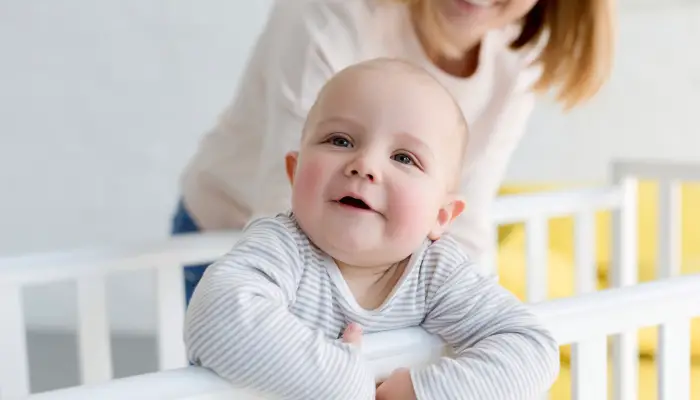
And, because babies grow so quickly in their first year, it seems like your baby outgrows her bassinet – and it’s time to think about those sleeping arrangements all over again.
As a new parent, you’ve probably fantasized about your little bundle of joy in cute pajamas napping peacefully in a crib with a smile tugging your baby’s lips. In anticipation, you may have even purchased the cutest crib. But unfortunately, getting your baby to sleep in his or their crib may be more difficult than you imagined.
Due to the need for continued care and feeding plans, you begin with your baby napping in the bassinet for the first months. In the possibility of a probable food emergency, it just appeared more beneficial to keep the baby near your bedside than feasible.
However, either on doctor’s orders or because your baby has outgrown the bassinet, the time will come to transition your baby to a crib. This could indicate a significant shift in your baby’s sleep schedule.
If you’re wondering when to move baby to crib or what it’ll be like to transition your baby to a crib, read this article to know more.
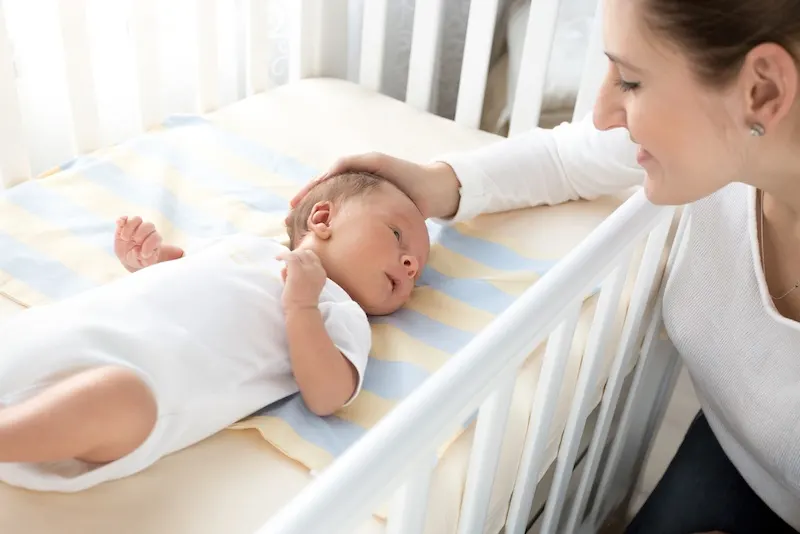
When to move baby to crib?
How do you know when your baby is ready to start sleeping in a crib?
You must determine whether the transition is appropriate. During the first few months, babies grow at an incredible exponential rate, with growth spurts. If your baby has outgrown the bassinet, it may be time to move him or her to a crib. You don’t like your baby to wake up crying because he or she bumped into the sides of the bassinet.
Most babies move into their crib between 3 and 6 months. If your baby is still napping peacefully in the bassinet, it may not be time to rush into a crib transition. However, the longer you wait, the more resistance your baby will encounter.
A younger baby would be easier to transition to a crib than an older baby who has grown accustomed to his or her bassinet. Also, avoid transitioning before a significant change in the baby’s environment, such as a vacation or moving into a new home.
Before transitioning to a crib, how long should a baby sleep in a bassinet?
When to move baby to crib from bassinet? Many newborns begin their sleeping lives in their parent’s room, in a bassinet, or in other bedside sleepers. This is convenient because you can comfort and feed your infant without shuffling down the hall in the dark. Furthermore, it adheres to the American Academy of Pediatrics recommendation that babies nap in the identical room as their father and mother – but not in the same bed – for at least the first six months.
When to move baby to crib from bassinet? There is no rigid rule for a baby to stop sleeping in a bassinet. It is determined by the weight limit of your bassinet and your child’s development (more on that below).
Not a fan of the bassinet? Newborns can sleep in a regular crib from the start. Whatever baby bed you choose in those early weeks and months, make sure it meets the Consumer Product Safety Commission’s latest crib safety guidelines (CPSC).
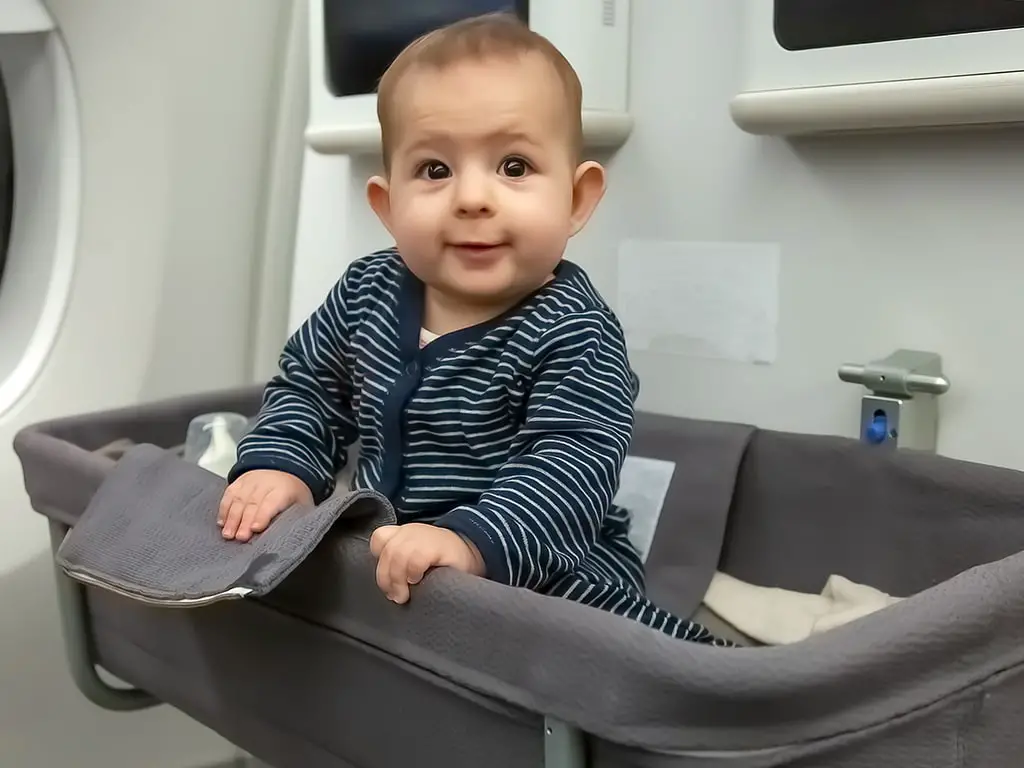
When to move baby to crib? How do I understand?
When several factors determine your baby’s transition to a crib. Here are some queries to consider when deciding when to make the switch:
- How big is your child?
Bassinets and other bedside sleepers are excellent for newborns, but they usually have weight restrictions. Some are as light as 10 pounds (which may only last a month), but most can hold a 20-pound baby.
Your weight limit can be found in the instruction manual or on the manufacturer’s website. If you can’t find the weight limit, err on the side of safety and place your child in a crib when she reaches 15 pounds.
- Are they squeezing in?
Even if your baby hasn’t reached her bassinet’s weight limit, it may become too snug. Examine them the next time you put them down. Are they squeezing in?
If their head or feet are rubbing against the sides or ends of the bassinet, or if they are waking up frequently (or unexpectedly), it may be time to give her a little more room.
- Can your babe sit up or roll over in the bassinet?
It’s exciting to see your baby reach new milestones, but the more your infant can do, the riskier it is to nap in a bed designed for newborns. Because bassinets are often shallower than cribs, a baby rolling or about to sit up may flip out.
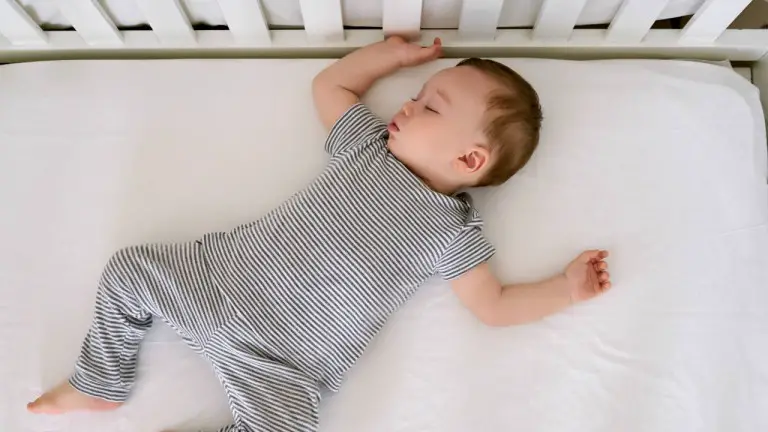
When to move baby to crib? Some other signs that it’s time to make a change
Even if you don’t notice any physical changes that indicate you should move the baby to their crib, some of these signs may help you understand what’s best for your baby if:
- Your baby has started waking up more frequently during the night, especially at unusual times; this indicates that the baby is used to their bassinet but is not completely comfortable.
- If your baby is frequently stuck in an uncomfortable position, they are cramped inside the bassinet and outgrowing it.
- You notice your baby waking up grumpier than usual; perhaps they’re not having a good time in their bassinet.
- If you find your baby kicking the bassinet in the middle of the night, they are probably feeling cramped in there.
- If the baby doesn’t have about 2 inches of clearance at the top and bottom and is difficult to move, it’s time to consider a switch.
Things to consider when transitioning your baby
The most difficult part of transitioning your baby to a crib has to be ‘transitioning the baby.’ It may appear confusing at first, and you may have numerous questions about the process. When to move baby to crib? How do I get my baby to sleep in his or her crib? What can I do to make my infant feel more at ease?
To begin, the American Academy of Pediatrics recommends the following steps to help your baby transition to the crib:
- A full-size crib to accommodate monthly growth spurts. As a result, the crib is both adaptable and spacious.
- A healthy mattress to help the baby sleep better and avoid aches and pains. Your baby may lack the strength to push away from a soft mattress, severing the air supply. The firm bed would keep the baby from falling asleep in a dangerous position.
- A clear sleeping area with no pillows or blankets interfering with your baby’s sleep. This is also to keep your baby safe while he or she is tossing and turning.
- Setting your newborn to sleep on their back – This is the most secure sleeping position. This reduces the hazard of Sudden Infant Death Syndrome (SIDS) and allows your baby to sleep comfortably.
Some other things to consider when transitioning your baby
- Check that the crib meets all of the safety standards
When to move baby to crib? Before moving, arrange for a crib first. When shopping for a crib, ensure you get the best crib from a reputable brand. Check if the crib meets the Consumer Product Safety Commission’s recommended safety standards (CPSC).
- Examine the Dimensions
When to move baby to crib? Before moving, check the dimensions of the crib. The standard crib size is 71 cm x 132 cm (28″ x 52″ inches), and the crib bars or slats should be 2 3/8″ (6 cm) wide to prevent your baby from falling out or being trapped between the slats.
- Look for a Firm Mattress that Fits Snugly
When to move baby to crib? Before moving, buy a firm mattress. Purchase a firm mattress that fits snugly in the crib for optimal back support for your baby. We recommend reading the complete crib mattress buying guide to learn how to choose the right crib mattress.
- The mattress should fit so tightly that you cannot fit more than two fingers between the mattress and the crib sides.
- This protects your baby from being trapped or suffocating in gaps around the mattress.
- Your toddler may quickly learn to escape the crib if the crib mattress is thicker than 6 inches.
- The crib sheet should also be snug and have elastic all around for a perfect fit because loose sheets can cause entanglement and suffocation.
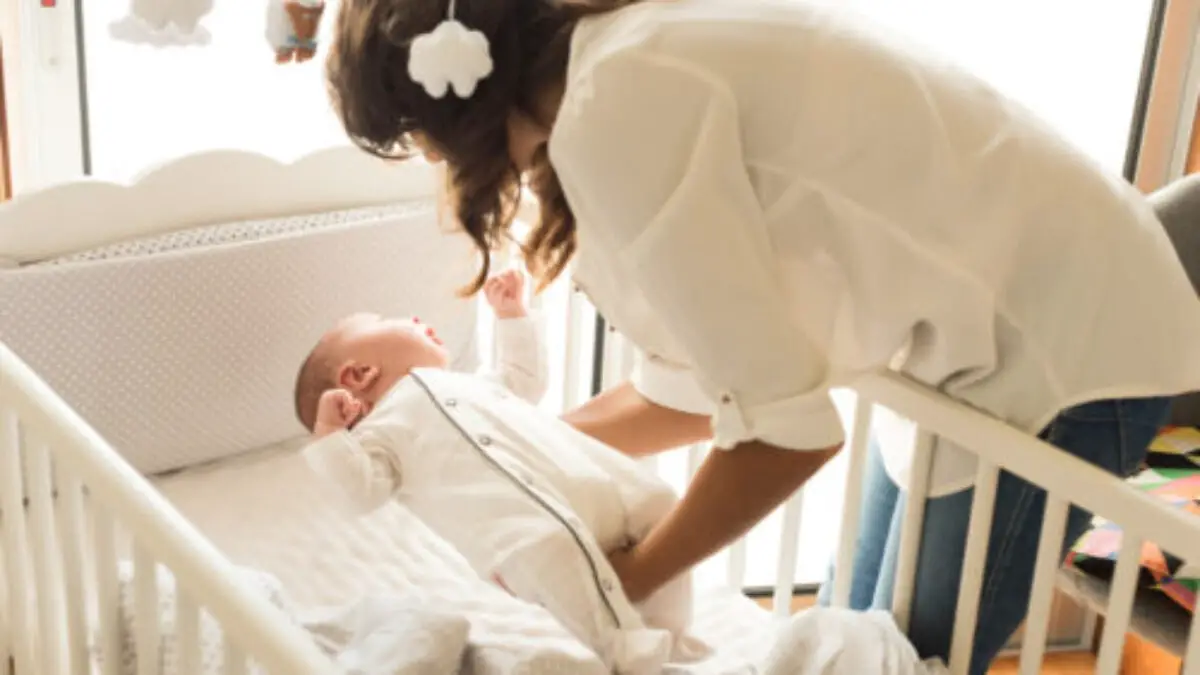
- Check for cutouts on the headboard, footboards, and drop-side rails that are not large
Before moving, check the cutouts on the headboard, footboards, and drop-side rails are not large. Headboards and footboards in cribs may appear elegant, but they can endanger your baby’s safety if they have large cutout designs or spaces. As a result, if you prefer a headboard or footboard crib, look for one with a solid design or minimal cutouts that are not in any way dangerous.
Furthermore, never settle for a drop-side crib, no matter how safe it claims to be. This is because drop-side rail cribs are more dangerous than convenient.
Also Read: Morning Sickness- Causes, Treatment And 12 Best Tips To Overcome
When to move baby to crib? What not to do when transferring your baby to a crib?
Now that you know when to move your baby to the crib and what to think about, it’s also important to remember that even if your child reaches the age or weight benchmark but is sleeping peacefully in their bassinet, you don’t have to force them to make the switch. However, don’t put it off too long because the longer the baby sleeps in their bassinet, the more likely they resist.
When to move baby to a crib? How?
Arrangements
If the toddler has difficulty transitioning, new parents are often discouraged and stop their babies from sleeping in cribs. Remember that babies do not develop a new habit of sleeping in cribs overnight.
Every child (and parent) finds adjusting to their new surroundings difficult. Some toddlers, however, may take a little longer to change their beds. Here are a few pro tips to help your baby sleep in their crib like other babies sleeping in cribs.
- Prepare the Crib for Your Baby
As soon as you discover your baby is about to transition to a crib, choose the best crib and compile it.
- Select the appropriate mattress and crib sheets.
- Check for loose or improperly installed screws and ensure the mattress height is correct.
- Check the crib for any missing brackets or other hardware.
- Also, ensure that the wheels are properly locked and that the crib is safe according to the recommended safety standards.
- Locate the Appropriate Location
Finding the right spot is critical for the nursery’s design or theme and the baby’s comfort and safety. Place the crib appropriately, away from windows, draperies, heaters, lamps, blind cords, etc. Even if the baby cannot move out of their crib, placing it in a safe location will keep them safe against all odds.
- Include Some Eye-Catching Elements
Although crowding the crib with soft toys and pillows is dangerous and may cause suffocation, you can add attractive elements to the nursery, such as crib mobiles, dim lights, eye-catching lamps, white noise, and so on.
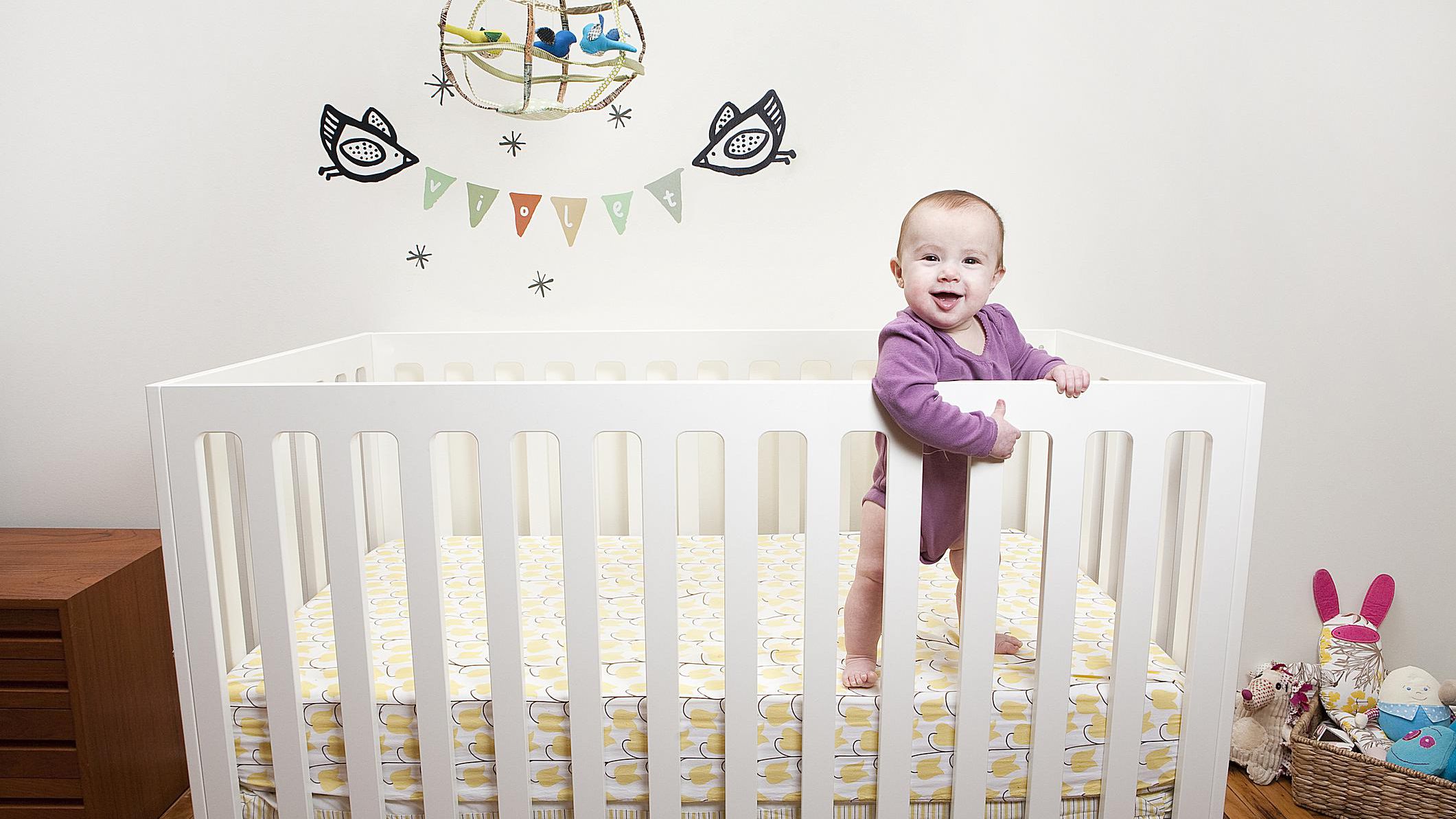
Transition
Some babies may not notice the change and will happily sleep wherever you put them. If you’re concerned that the change will cause your child to have trouble sleeping, here are a few suggestions to help with the transition to a crib:
- Prepare the Crib
When to move baby to a crib? How? Making the crib extra comfortable is a great way to get your baby to start sleeping in it. When placing the baby in the crib, ensure the crib sheet is not too cold, as this could wake the baby up. A sleep sack is an excellent way to wean your baby off swaddling and keep him or her warm in the crib.
If your baby enjoys being near you before falling asleep, he or she will most likely crave your scent while sleeping. Before transitioning, try sleeping on the crib sheets so that the sheets smell like you and you can create the illusion of being nearby.
- Gradually transition
Your baby must feel secure in his or her crib, which cannot be achieved overnight. Before fully transitioning, your baby must feel at ease in his or her crib. You can drag the crib into your room and have your baby sleep in it before returning it to your baby’s room.
You can also try putting your baby to sleep in his or her crib during the day before attempting to transition at bedtime. Another useful tip is to stay in the room until your baby falls asleep during the initial stage of transitioning and gradually reduce the time until your baby no longer requires you to fall asleep.
- Create a Routine
Babies generally have a predictable sleep cycle and thrive better when they have a sleep routine. Being consistent is beneficial to your child. During the first year, they find comfort in predictability and knowing what will happen next.
Create a routine based on your baby’s sleep patterns. Find out what functions best for your baby and stick to it to make the transition as painless as possible, especially for younger babies.
- Be Strong And Brace Yourself
Prepare for a whimper when you place your baby in his or her crib alone. Even when necessary, the transition process can be difficult. The baby may need some time to adjust to the new sleeping environment.
Observe objectively and try not to enter the room whenever the baby makes a noise. You can always use the baby monitor to ensure that everything is fine and that the baby is just fussy.
The goal is for your baby to learn to fall asleep on his or her own without assistance. Without a medical reason, babies can only fuss for so long.
- Sound Machines and Baby Monitors
The baby monitor allows you to monitor your baby during the transition period. You can monitor the baby’s sleeping patterns and transformations in temperature and humidity. It tracks your baby’s progress and improvements in falling asleep unaided to encourage parents.
Using white noise from a sound device to help your baby transition may be beneficial in controlling your baby from awakening at every sound in the house. If your baby is already accustomed to a specific white noise, try using it to help them sleep better in the crib and ease the transition.
The white noise would help to drown out any distracting noises, allowing the baby to get a good night’s sleep.
Duration of the Transition Process
A critical question, besides when to move baby to crib, is how long it should take to transition a baby to a crib. How much time is too much? How brief can time be?
The transition period has no set duration and could last anywhere from a few days to a few weeks, depending on how gradual the process is. It may also be determined by the baby’s readiness or resistance to transition to nighttime sleep in the crib.
Parenting has many ups and downs, no matter how prepared you are for the situation. With all the cries and fuss, transitioning your baby to the crib may seem like a nightmare, but each day will improve.
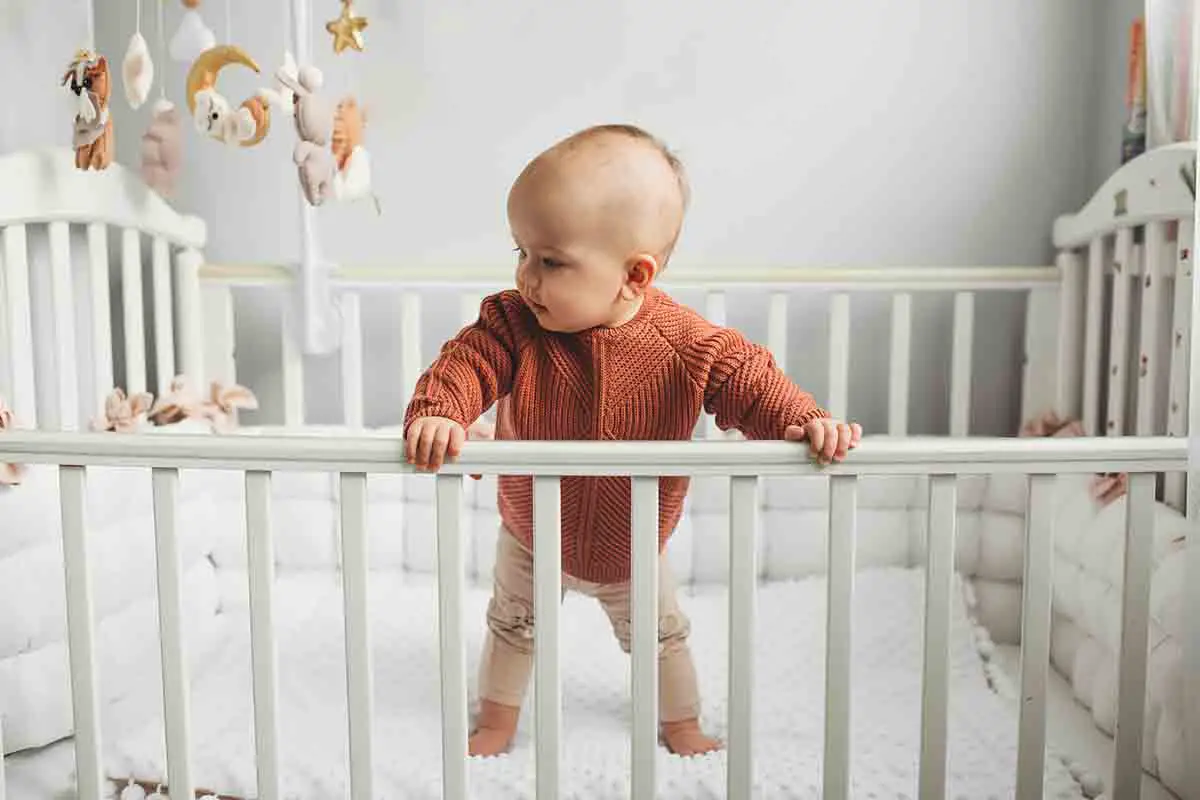
When to move baby to crib? Tips to make the transition easier
Here are some pointers to make your baby’s transition from bassinet to crib go as smoothly as possible.
- Position the crib in the same location as the bassinet
Putting the crib in the same spot where the bassinet was will make your child’s transition to their new bed much easier because nothing has changed much except the size of their bed.
- Slow down
When to move baby to crib? Shifting from a bassinet to a crib is a significant change for babies. Instead of forcing them to sleep in a crib immediately, take it slow and begin with naps. Once the baby is comfortable in the new bed, gradually transition it to their primary sleeping space.
- Maintain the Bedtime
When to move baby to crib? Although many toddlers initially resist sleeping in a crib, ensure the bedtime routine is not altered. This makes a huge difference in ensuring the baby’s body clock is set for sleep time.
- Sleep Next to the Baby
No! We are not discussing co-sleeping or sleeping in the crib. We’re talking about sleeping in the same room as the baby. After all, transitioning a baby from a bassinet to a crib is difficult for the baby and the mother.
- Exercise your patience
Even if you follow the advice you read online or hear from other moms, things may not always go as planned. Using your formula patiently and calmly to transition your baby to sleep will gradually make them feel more at ease with their new sleeping environment.

Bottom Line
Remember that, like physical development, each baby’s timing for all milestones is unique. Pay attention to your child and be patient with them. When to move baby to crib? You cannot push your child to sleep in an unfamiliar environment. Make them comfortable in their new surroundings and look for smarter ways to make the transition from bassinet to crib easier.
Even if your child cannot say goodbye to the bassinet, practicing every day and being consistent will help them adjust to their new bed. Ensure the nursery (or room) is dark enough and free of bright lights to ease the transition. Most notably, never leave your baby alone in his or her crib while sleeping.
Keep all extra pillows, soft toys, blankets, or bumper pads away from the crib during the night to keep it safe. Use a baby monitor to watch your child at all times. Remember to give your baby your scent in some way to make the crib feel like you. We wish you good luck as you shift your little angel to their crib!
Frequently asked questions on when to move baby to crib
- When to move baby to crib?
While most babies are ready to move to a crib by three or four months, some may not be ready until the sixth month. If your baby is too oversized for their bassinet or has reached the age of six months, you must begin gradually transitioning them into the crib.
- When should I discontinue utilizing a bassinet?
Bassinets should be used for an utmost of six months. Still, many other factors must be considered, including the baby’s weight and height, the recommended weight range of your bassinet, and, most importantly, your baby’s development.
- Can a two-month-old baby sleep in a crib?
Yes. A two-month-old baby is too young to begin sleep training and transitioning to a new bed. To sleep train your baby in their new sleep space, you must wait until they are at least three months old. Many people are unsure whether to use a bassinet or a crib to avoid the hassle of transitioning the baby. However, keeping newborns close is preferable, not placing them directly into cribs. It is preferable to place a two-month-old baby in a co-sleeper, bedside sleeper, or cradle.
- When should the baby be moved to his or her room?
You can move your baby to their nursery once they are comfortable sleeping in their crib. You should be able to do so when the baby is about 6-7 months old.

